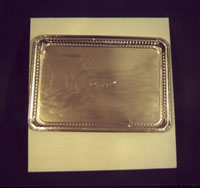Unusually Big Sparks With A Ridiculously Simple
Electrophorus
 Hopefully you have seen the web pages
at the Exploratorium
or The University
of Rochester about the electrophorus.
There is a lot in print about this device as well. My earliest experiences
with an electrophorus used a disposable pie pan and a foam plate. I was
pleased with the consistency of sparks, but they were always very
small. After a little research, I decided to give the electrophorus another
try. To my surprise, I found I could get big, visible sparks from a device
that is both easy to make and takes up very little space.
Hopefully you have seen the web pages
at the Exploratorium
or The University
of Rochester about the electrophorus.
There is a lot in print about this device as well. My earliest experiences
with an electrophorus used a disposable pie pan and a foam plate. I was
pleased with the consistency of sparks, but they were always very
small. After a little research, I decided to give the electrophorus another
try. To my surprise, I found I could get big, visible sparks from a device
that is both easy to make and takes up very little space.
If you want to do this here's what you'll need:
-
A sheet of plastic that you can charge by rubbing. It should
be rigid, and at least 14"x18". My best results thus far have been with
something called Cor-x. It is a common plastic sign board that resembles
corrugated cardboard (except it's plastic). In the U.S., the day after
a political election would be a good time to get some Cor-x. Plexiglas
works and rigid foam insulation (Styrofoam) may work too. Try what is available
to you.
-
A disposable (or not) aluminum cookie sheet. It is critical
that the sheet be absolutely flat, clean, and smooth. If you go buy one,
select it by hand and don't let the supermarket clerk damage it.
It also needs "rolled" edges, meaning that the edges are rolled over to
make them round and smooth. Finally, it needs to be smaller than the plastic
sheet. My cookie sheets are about 11"x15".
-
Something to rub the plastic with, to charge it.
-
Dry weather.
A feature of the standard electrophorus
is an insulating handle on the metal part. We will skip that step for now.
The pan will do do nicely as it is.
Start by finding a flat surface that
is grounded. Lay down your plastic sheet and charge it up by rubbing it
with fur, or wool, or whatever works best. You should notice signs of electricity,
like hearing sparks, as you rub.
Next, pick up the cookie sheet and
hold it 4 or 5 inches above the plastic sheet. Drop it. Now, If you draw
your finger near the pan's edge, you will get a spark. Using a rounded
metal object for this is less painful (don't use a pointed metal object,
the rounder, the better).
You have only just begun. Pick up
the pan again and drop it the same way. You can now take another spark
off of it. The kinetic energy of picking up the pan is transformed partly
into electrical energy. You can do this over and over again.
Here's where I tell you how
to make an inch long spark, instead of 1/8 inch sparks: Start over
and charge the plastic by rubbing it. Drop the pan on it as before. Now,
carefully pick up the ENTIRE apparatus, keeping your fingers as far
from the edges of the pan as you can. While holding it up in the air,
discharge the pan by bringing a rounded metal object near its edge
. This method produces amazingly long sparks, considering how simple it
is.
The sheet of plastic must be larger
than the pan. This is so you can pick it up and still keep your fingers
some distance from the edge of the pan. It also has to be somewhat rigid,
so it stays flat when you pick it up. The sheet also
needs to be "chargeable." Before you go in search of a new sheet of plastic
make sure that you have tried charging it with a variety of materials.
I was lamenting over a sheet of Plexiglas that I couldn't charge by rubbing,
but found it will charge with a rubber roller.
I've also found that it's important
not to dawdle between picking up the electrophorus and taking the spark
off it. The longer you wait the smaller the spark will be (usually).
The sparks you get from an electrophorus
may not always be as bright and loud as those you get off a charged Leyden
jar, but they can be long, indicating very high voltage. If you want more
visible (and audible) sparks you can use this device to charge a Leyden
jar. Here's how: Instead of taking the spark off with your finger or
a round metal object, take it off with the terminal ball on a Leyden jar.
Repeat that a dozen times or so, then discharge the jar. Yowza!
So, does anyone know the plural of
"electrophorus"?
Back to the Static Generator Page
P.S.- If you use this page to do an experiment, science
fair, or other project, send me an
e-mail and tell me how it went. I need feedback to be sure I've included
all the information needed to make an impressive spark!